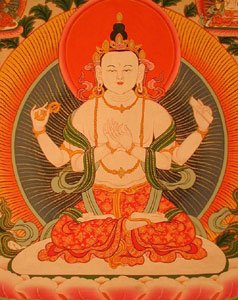
The Heart Sūtra, belonging to the Perfection of Wisdom (Prajñāpāramitā) category of Mahāyāna Buddhism literature along with the Diamond Sūtra, is perhaps the most prominent representative of the genre.
The earliest extant text of the Heart Sūtra is the palm-leaf manuscript found at the Horyuji Temple, and dated to 609 CE. It was one of two texts which formed the basis for a published edition by Max Müller (1881), and formed the basis of a published edition by Shaku Hannya (1923). However it is important to note that a comparison of the script with India manuscripts and inscriptions argues for a date in the 8th century for the Horyuji manuscript.[1]
Though we perceive a world of concrete and discrete objects, these objects are "empty" of the identity imputed by their designated labels. The Heart sutra, articulates this in the following saying in which the five skandhas are said to be "empty":
Form is emptiness, emptiness is form
Emptiness is not separate from form, form is not separate from emptiness
Whatever is form is emptiness, whatever is emptiness is form.
[2]
